Literature Review – Web and Society
VerifiedAdded on 2023/06/07
|19
|4354
|214
AI Summary
This literature review explores the impact of web and society through various topics such as social media, online interactions, digital democracy and more. It includes a broad scan, research journal, filing system, bibliographic file, focused review, and five different hacks for digital democracy. The review also includes subject areas such as sociology, psychology, and computer science.
Contribute Materials
Your contribution can guide someone’s learning journey. Share your
documents today.
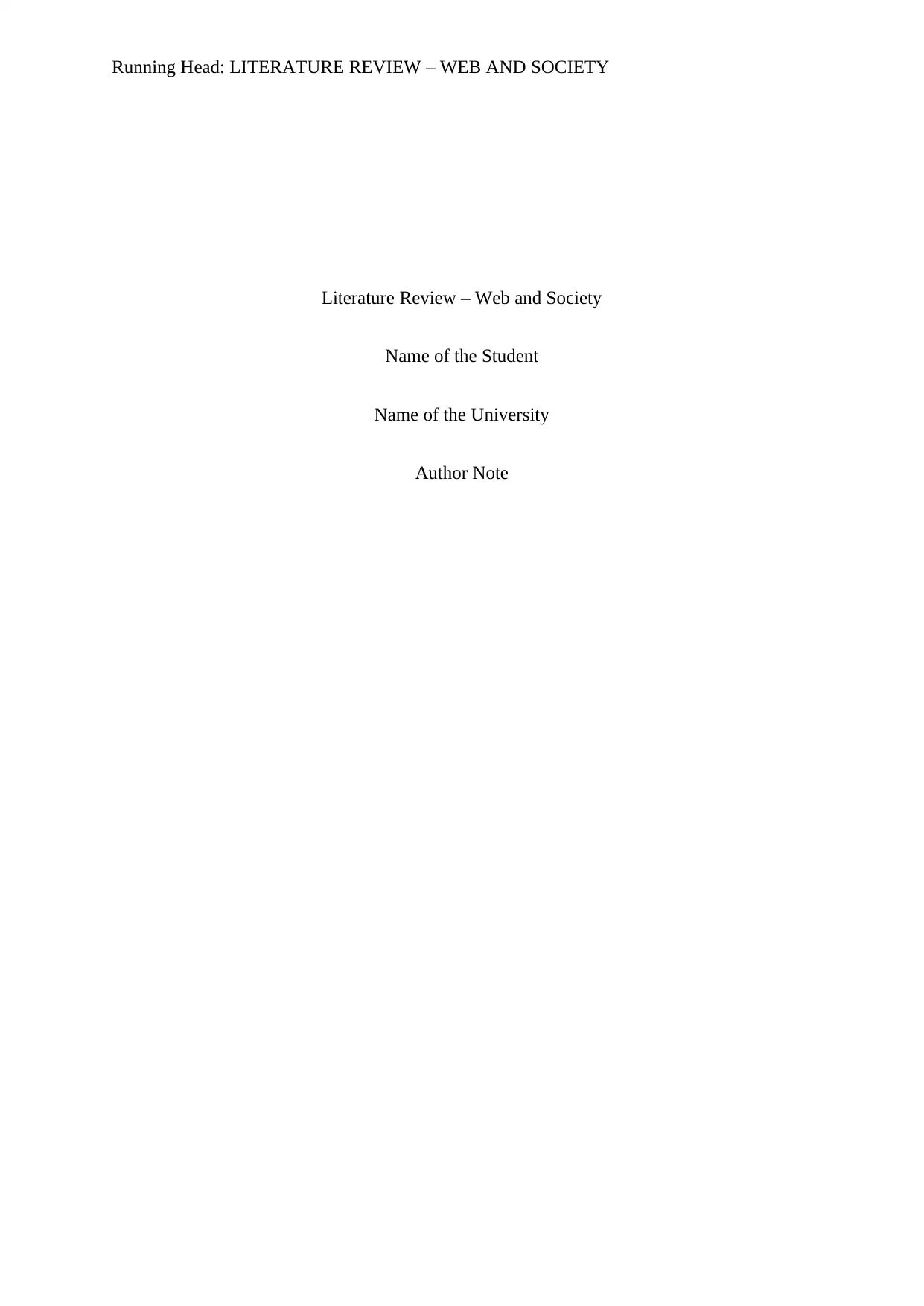
Running Head: LITERATURE REVIEW – WEB AND SOCIETY
Literature Review – Web and Society
Name of the Student
Name of the University
Author Note
Literature Review – Web and Society
Name of the Student
Name of the University
Author Note
Secure Best Marks with AI Grader
Need help grading? Try our AI Grader for instant feedback on your assignments.

1LITERATURE REVIEW – WEB AND SOCIETY
Table of Contents
1. Literature Review...............................................................................................................4
1.1. Broad Scan...................................................................................................................4
1.2. Research Journal..........................................................................................................4
1.3. Filing System...............................................................................................................6
1.4. Bibliographic File Derived from Broad Scan..............................................................7
1.5. Focused Review...........................................................................................................9
1.6. Updated Filing System................................................................................................9
1.7. Updated Bibliographic File from Focused Review...................................................10
1.8. Five Different Hacks for Digital Democracy............................................................11
1.8.1. Background............................................................................................................11
1.8.2. Framework and Research Methods........................................................................12
1.8.3. Discussion and Analysis........................................................................................12
1.9. Understanding the Social Psychology of the Internet...............................................14
1.9.1. Background............................................................................................................14
1.9.2. Research Methods..................................................................................................14
1.9.3. Discussion..............................................................................................................15
1.9.4. Conclusion.............................................................................................................16
1.9.5. Final Chapter Outline.............................................................................................16
1.9.6. Introduction................................................................................................................16
List of References....................................................................................................................18
Table of Contents
1. Literature Review...............................................................................................................4
1.1. Broad Scan...................................................................................................................4
1.2. Research Journal..........................................................................................................4
1.3. Filing System...............................................................................................................6
1.4. Bibliographic File Derived from Broad Scan..............................................................7
1.5. Focused Review...........................................................................................................9
1.6. Updated Filing System................................................................................................9
1.7. Updated Bibliographic File from Focused Review...................................................10
1.8. Five Different Hacks for Digital Democracy............................................................11
1.8.1. Background............................................................................................................11
1.8.2. Framework and Research Methods........................................................................12
1.8.3. Discussion and Analysis........................................................................................12
1.9. Understanding the Social Psychology of the Internet...............................................14
1.9.1. Background............................................................................................................14
1.9.2. Research Methods..................................................................................................14
1.9.3. Discussion..............................................................................................................15
1.9.4. Conclusion.............................................................................................................16
1.9.5. Final Chapter Outline.............................................................................................16
1.9.6. Introduction................................................................................................................16
List of References....................................................................................................................18
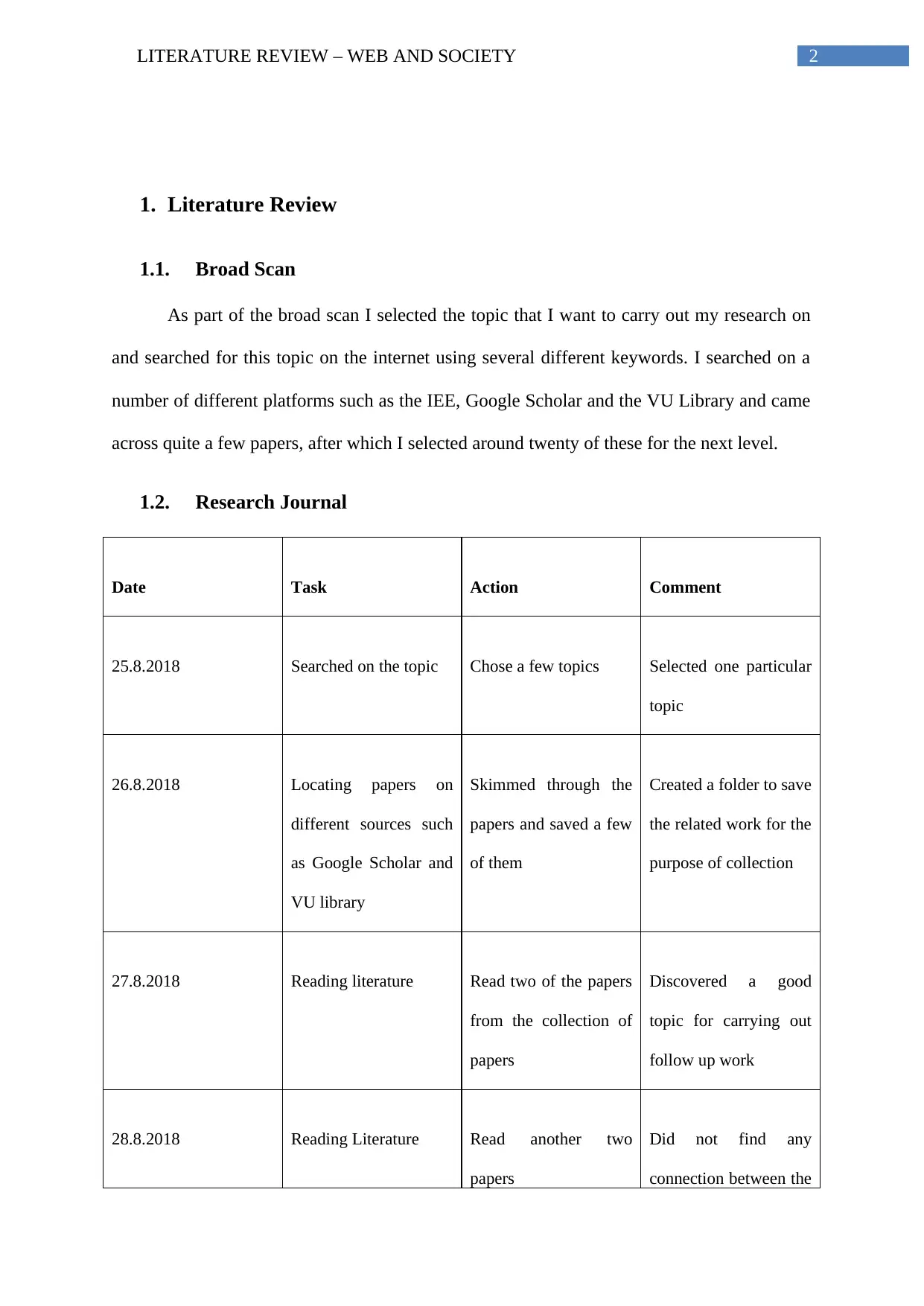
2LITERATURE REVIEW – WEB AND SOCIETY
1. Literature Review
1.1. Broad Scan
As part of the broad scan I selected the topic that I want to carry out my research on
and searched for this topic on the internet using several different keywords. I searched on a
number of different platforms such as the IEE, Google Scholar and the VU Library and came
across quite a few papers, after which I selected around twenty of these for the next level.
1.2. Research Journal
Date Task Action Comment
25.8.2018 Searched on the topic Chose a few topics Selected one particular
topic
26.8.2018 Locating papers on
different sources such
as Google Scholar and
VU library
Skimmed through the
papers and saved a few
of them
Created a folder to save
the related work for the
purpose of collection
27.8.2018 Reading literature Read two of the papers
from the collection of
papers
Discovered a good
topic for carrying out
follow up work
28.8.2018 Reading Literature Read another two
papers
Did not find any
connection between the
1. Literature Review
1.1. Broad Scan
As part of the broad scan I selected the topic that I want to carry out my research on
and searched for this topic on the internet using several different keywords. I searched on a
number of different platforms such as the IEE, Google Scholar and the VU Library and came
across quite a few papers, after which I selected around twenty of these for the next level.
1.2. Research Journal
Date Task Action Comment
25.8.2018 Searched on the topic Chose a few topics Selected one particular
topic
26.8.2018 Locating papers on
different sources such
as Google Scholar and
VU library
Skimmed through the
papers and saved a few
of them
Created a folder to save
the related work for the
purpose of collection
27.8.2018 Reading literature Read two of the papers
from the collection of
papers
Discovered a good
topic for carrying out
follow up work
28.8.2018 Reading Literature Read another two
papers
Did not find any
connection between the
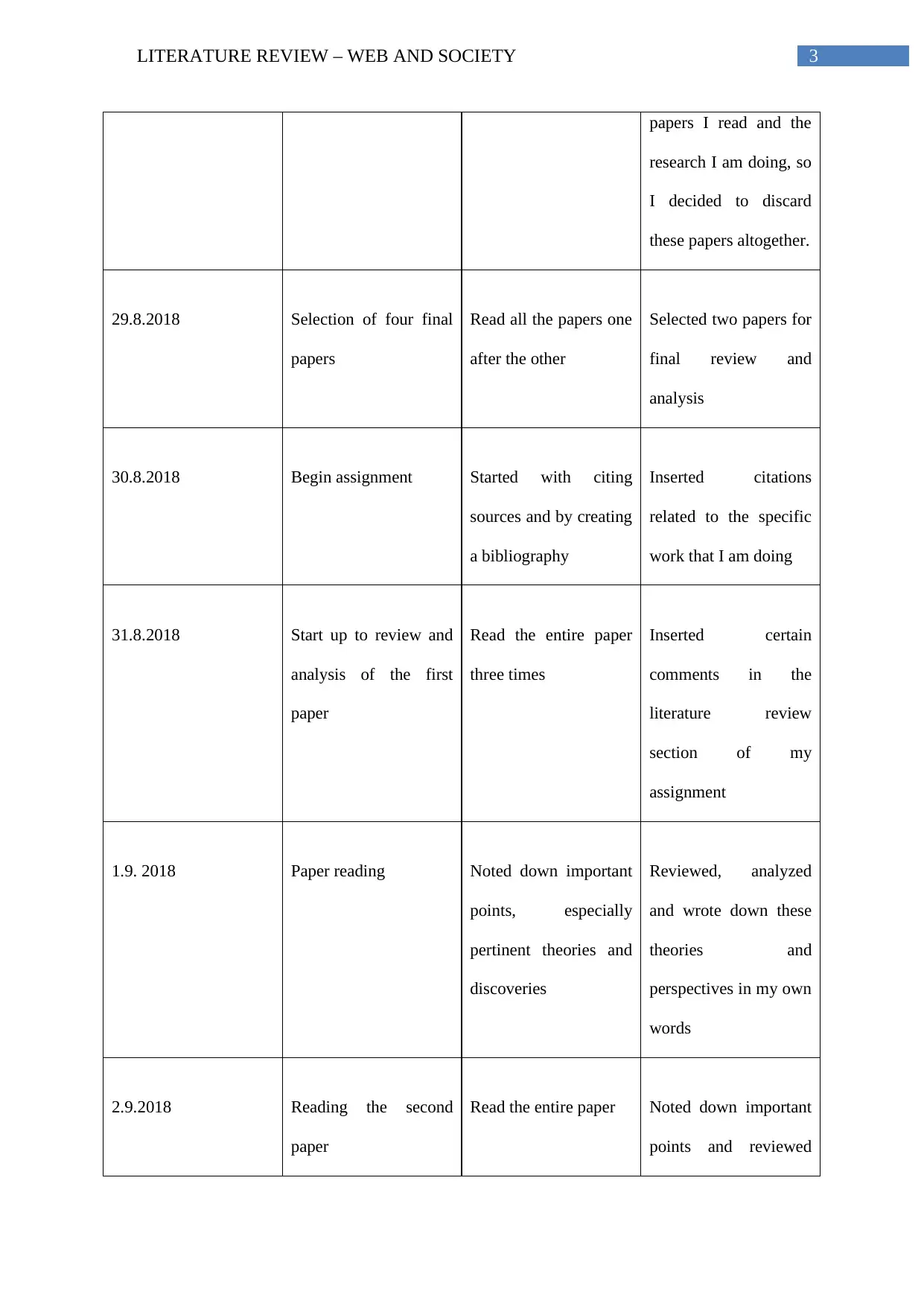
3LITERATURE REVIEW – WEB AND SOCIETY
papers I read and the
research I am doing, so
I decided to discard
these papers altogether.
29.8.2018 Selection of four final
papers
Read all the papers one
after the other
Selected two papers for
final review and
analysis
30.8.2018 Begin assignment Started with citing
sources and by creating
a bibliography
Inserted citations
related to the specific
work that I am doing
31.8.2018 Start up to review and
analysis of the first
paper
Read the entire paper
three times
Inserted certain
comments in the
literature review
section of my
assignment
1.9. 2018 Paper reading Noted down important
points, especially
pertinent theories and
discoveries
Reviewed, analyzed
and wrote down these
theories and
perspectives in my own
words
2.9.2018 Reading the second
paper
Read the entire paper Noted down important
points and reviewed
papers I read and the
research I am doing, so
I decided to discard
these papers altogether.
29.8.2018 Selection of four final
papers
Read all the papers one
after the other
Selected two papers for
final review and
analysis
30.8.2018 Begin assignment Started with citing
sources and by creating
a bibliography
Inserted citations
related to the specific
work that I am doing
31.8.2018 Start up to review and
analysis of the first
paper
Read the entire paper
three times
Inserted certain
comments in the
literature review
section of my
assignment
1.9. 2018 Paper reading Noted down important
points, especially
pertinent theories and
discoveries
Reviewed, analyzed
and wrote down these
theories and
perspectives in my own
words
2.9.2018 Reading the second
paper
Read the entire paper Noted down important
points and reviewed
Secure Best Marks with AI Grader
Need help grading? Try our AI Grader for instant feedback on your assignments.
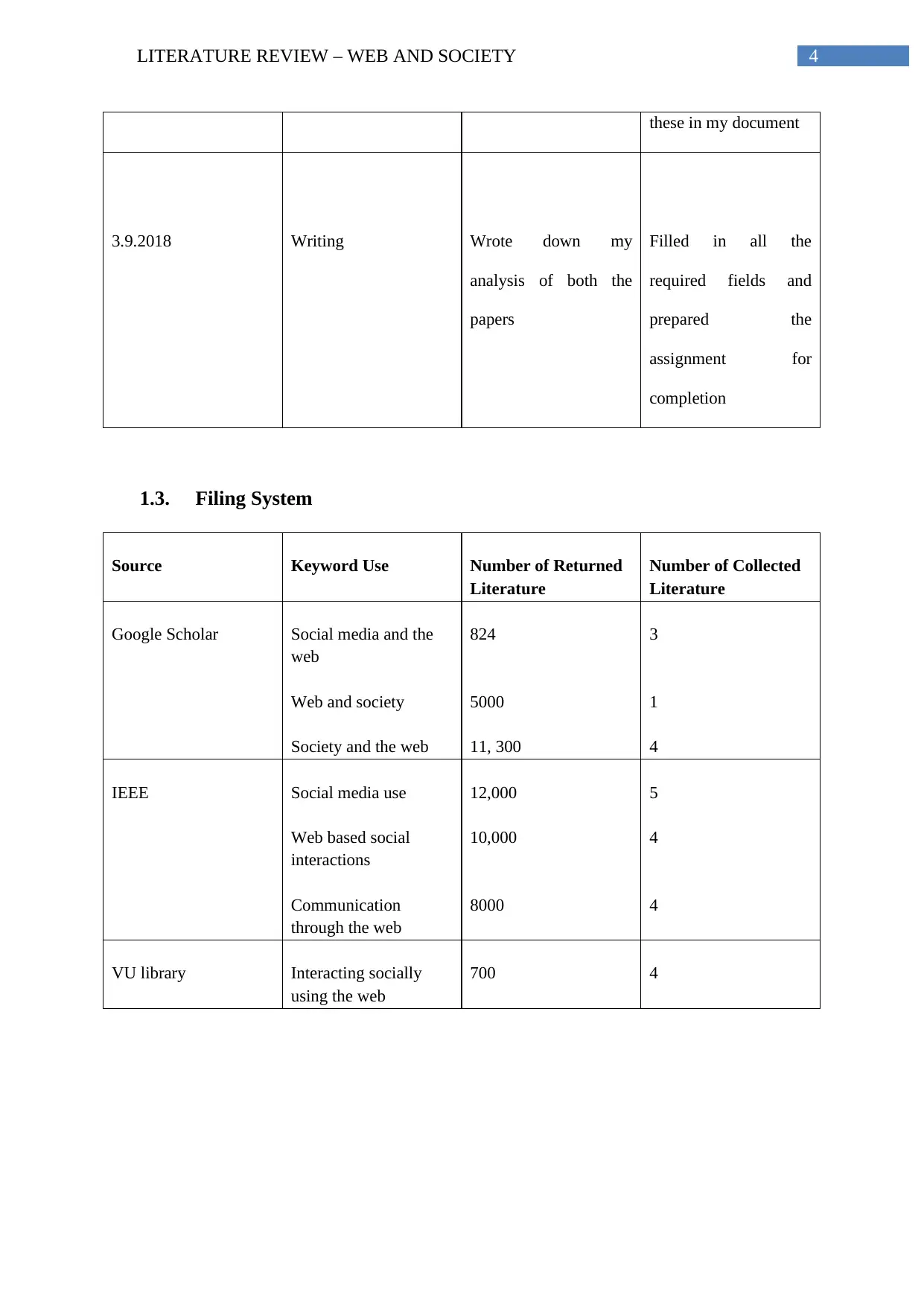
4LITERATURE REVIEW – WEB AND SOCIETY
these in my document
3.9.2018 Writing Wrote down my
analysis of both the
papers
Filled in all the
required fields and
prepared the
assignment for
completion
1.3. Filing System
Source Keyword Use Number of Returned
Literature
Number of Collected
Literature
Google Scholar Social media and the
web
Web and society
Society and the web
824
5000
11, 300
3
1
4
IEEE Social media use
Web based social
interactions
Communication
through the web
12,000
10,000
8000
5
4
4
VU library Interacting socially
using the web
700 4
these in my document
3.9.2018 Writing Wrote down my
analysis of both the
papers
Filled in all the
required fields and
prepared the
assignment for
completion
1.3. Filing System
Source Keyword Use Number of Returned
Literature
Number of Collected
Literature
Google Scholar Social media and the
web
Web and society
Society and the web
824
5000
11, 300
3
1
4
IEEE Social media use
Web based social
interactions
Communication
through the web
12,000
10,000
8000
5
4
4
VU library Interacting socially
using the web
700 4
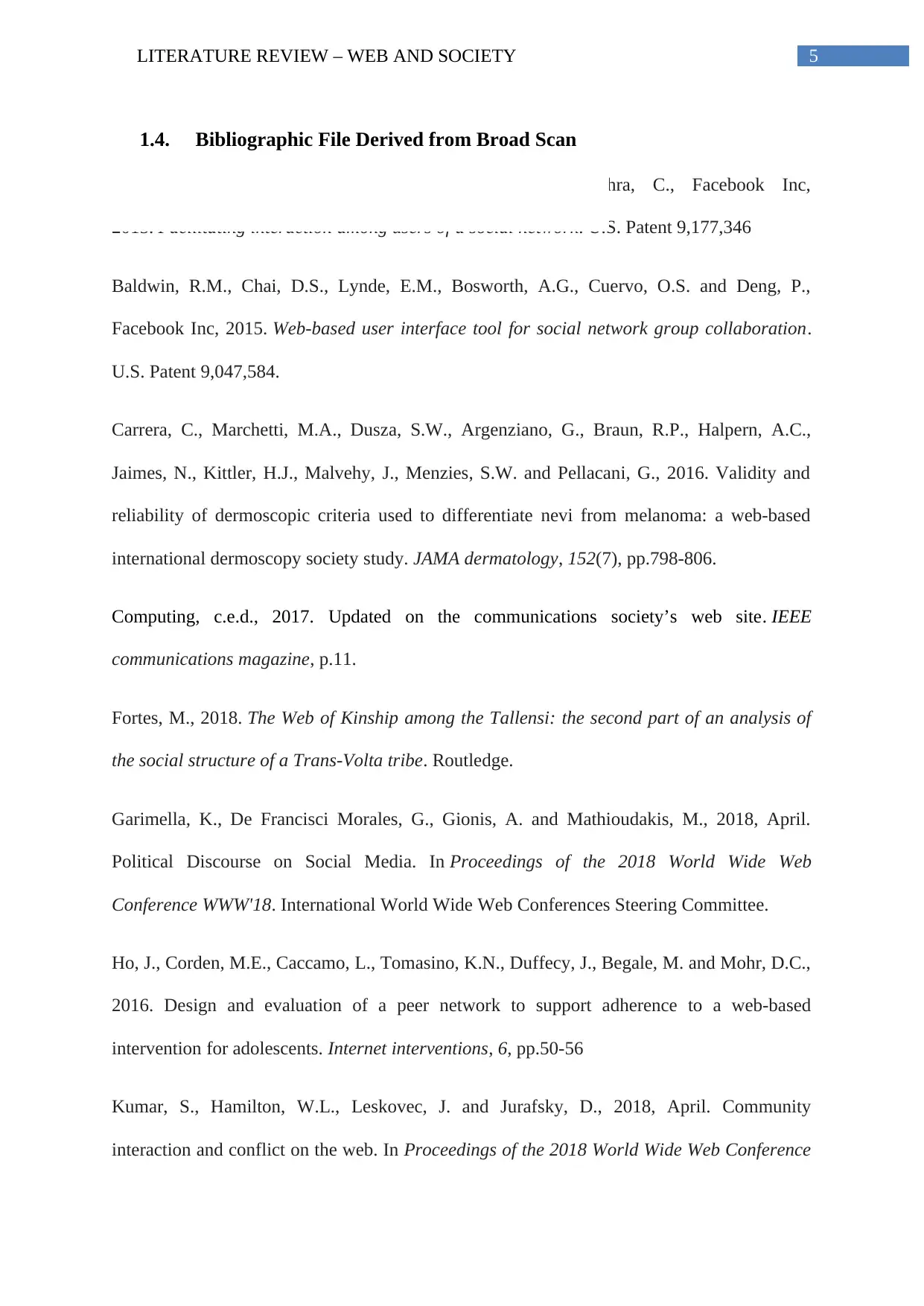
5LITERATURE REVIEW – WEB AND SOCIETY
1.4. Bibliographic File Derived from Broad Scan
Ahrens, S.G., Marlow, C.A., Backstrom, L.S. and Mishra, C., Facebook Inc,
2015. Facilitating interaction among users of a social network. U.S. Patent 9,177,346
Baldwin, R.M., Chai, D.S., Lynde, E.M., Bosworth, A.G., Cuervo, O.S. and Deng, P.,
Facebook Inc, 2015. Web-based user interface tool for social network group collaboration.
U.S. Patent 9,047,584.
Carrera, C., Marchetti, M.A., Dusza, S.W., Argenziano, G., Braun, R.P., Halpern, A.C.,
Jaimes, N., Kittler, H.J., Malvehy, J., Menzies, S.W. and Pellacani, G., 2016. Validity and
reliability of dermoscopic criteria used to differentiate nevi from melanoma: a web-based
international dermoscopy society study. JAMA dermatology, 152(7), pp.798-806.
Computing, c.e.d., 2017. Updated on the communications society’s web site. IEEE
communications magazine, p.11.
Fortes, M., 2018. The Web of Kinship among the Tallensi: the second part of an analysis of
the social structure of a Trans-Volta tribe. Routledge.
Garimella, K., De Francisci Morales, G., Gionis, A. and Mathioudakis, M., 2018, April.
Political Discourse on Social Media. In Proceedings of the 2018 World Wide Web
Conference WWW'18. International World Wide Web Conferences Steering Committee.
Ho, J., Corden, M.E., Caccamo, L., Tomasino, K.N., Duffecy, J., Begale, M. and Mohr, D.C.,
2016. Design and evaluation of a peer network to support adherence to a web-based
intervention for adolescents. Internet interventions, 6, pp.50-56
Kumar, S., Hamilton, W.L., Leskovec, J. and Jurafsky, D., 2018, April. Community
interaction and conflict on the web. In Proceedings of the 2018 World Wide Web Conference
1.4. Bibliographic File Derived from Broad Scan
Ahrens, S.G., Marlow, C.A., Backstrom, L.S. and Mishra, C., Facebook Inc,
2015. Facilitating interaction among users of a social network. U.S. Patent 9,177,346
Baldwin, R.M., Chai, D.S., Lynde, E.M., Bosworth, A.G., Cuervo, O.S. and Deng, P.,
Facebook Inc, 2015. Web-based user interface tool for social network group collaboration.
U.S. Patent 9,047,584.
Carrera, C., Marchetti, M.A., Dusza, S.W., Argenziano, G., Braun, R.P., Halpern, A.C.,
Jaimes, N., Kittler, H.J., Malvehy, J., Menzies, S.W. and Pellacani, G., 2016. Validity and
reliability of dermoscopic criteria used to differentiate nevi from melanoma: a web-based
international dermoscopy society study. JAMA dermatology, 152(7), pp.798-806.
Computing, c.e.d., 2017. Updated on the communications society’s web site. IEEE
communications magazine, p.11.
Fortes, M., 2018. The Web of Kinship among the Tallensi: the second part of an analysis of
the social structure of a Trans-Volta tribe. Routledge.
Garimella, K., De Francisci Morales, G., Gionis, A. and Mathioudakis, M., 2018, April.
Political Discourse on Social Media. In Proceedings of the 2018 World Wide Web
Conference WWW'18. International World Wide Web Conferences Steering Committee.
Ho, J., Corden, M.E., Caccamo, L., Tomasino, K.N., Duffecy, J., Begale, M. and Mohr, D.C.,
2016. Design and evaluation of a peer network to support adherence to a web-based
intervention for adolescents. Internet interventions, 6, pp.50-56
Kumar, S., Hamilton, W.L., Leskovec, J. and Jurafsky, D., 2018, April. Community
interaction and conflict on the web. In Proceedings of the 2018 World Wide Web Conference
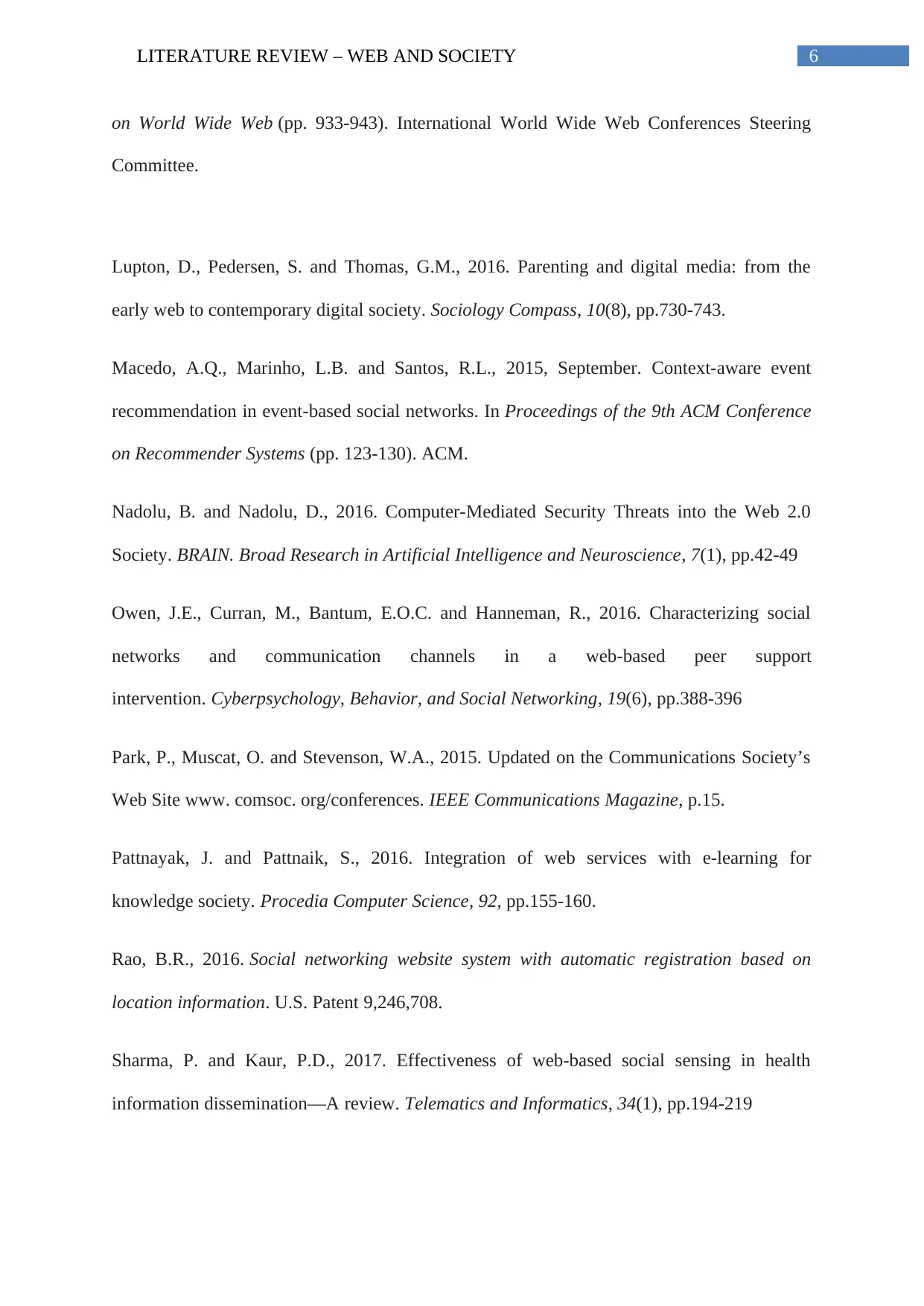
6LITERATURE REVIEW – WEB AND SOCIETY
on World Wide Web (pp. 933-943). International World Wide Web Conferences Steering
Committee.
Lupton, D., Pedersen, S. and Thomas, G.M., 2016. Parenting and digital media: from the
early web to contemporary digital society. Sociology Compass, 10(8), pp.730-743.
Macedo, A.Q., Marinho, L.B. and Santos, R.L., 2015, September. Context-aware event
recommendation in event-based social networks. In Proceedings of the 9th ACM Conference
on Recommender Systems (pp. 123-130). ACM.
Nadolu, B. and Nadolu, D., 2016. Computer-Mediated Security Threats into the Web 2.0
Society. BRAIN. Broad Research in Artificial Intelligence and Neuroscience, 7(1), pp.42-49
Owen, J.E., Curran, M., Bantum, E.O.C. and Hanneman, R., 2016. Characterizing social
networks and communication channels in a web-based peer support
intervention. Cyberpsychology, Behavior, and Social Networking, 19(6), pp.388-396
Park, P., Muscat, O. and Stevenson, W.A., 2015. Updated on the Communications Society’s
Web Site www. comsoc. org/conferences. IEEE Communications Magazine, p.15.
Pattnayak, J. and Pattnaik, S., 2016. Integration of web services with e-learning for
knowledge society. Procedia Computer Science, 92, pp.155-160.
Rao, B.R., 2016. Social networking website system with automatic registration based on
location information. U.S. Patent 9,246,708.
Sharma, P. and Kaur, P.D., 2017. Effectiveness of web-based social sensing in health
information dissemination—A review. Telematics and Informatics, 34(1), pp.194-219
on World Wide Web (pp. 933-943). International World Wide Web Conferences Steering
Committee.
Lupton, D., Pedersen, S. and Thomas, G.M., 2016. Parenting and digital media: from the
early web to contemporary digital society. Sociology Compass, 10(8), pp.730-743.
Macedo, A.Q., Marinho, L.B. and Santos, R.L., 2015, September. Context-aware event
recommendation in event-based social networks. In Proceedings of the 9th ACM Conference
on Recommender Systems (pp. 123-130). ACM.
Nadolu, B. and Nadolu, D., 2016. Computer-Mediated Security Threats into the Web 2.0
Society. BRAIN. Broad Research in Artificial Intelligence and Neuroscience, 7(1), pp.42-49
Owen, J.E., Curran, M., Bantum, E.O.C. and Hanneman, R., 2016. Characterizing social
networks and communication channels in a web-based peer support
intervention. Cyberpsychology, Behavior, and Social Networking, 19(6), pp.388-396
Park, P., Muscat, O. and Stevenson, W.A., 2015. Updated on the Communications Society’s
Web Site www. comsoc. org/conferences. IEEE Communications Magazine, p.15.
Pattnayak, J. and Pattnaik, S., 2016. Integration of web services with e-learning for
knowledge society. Procedia Computer Science, 92, pp.155-160.
Rao, B.R., 2016. Social networking website system with automatic registration based on
location information. U.S. Patent 9,246,708.
Sharma, P. and Kaur, P.D., 2017. Effectiveness of web-based social sensing in health
information dissemination—A review. Telematics and Informatics, 34(1), pp.194-219
Paraphrase This Document
Need a fresh take? Get an instant paraphrase of this document with our AI Paraphraser
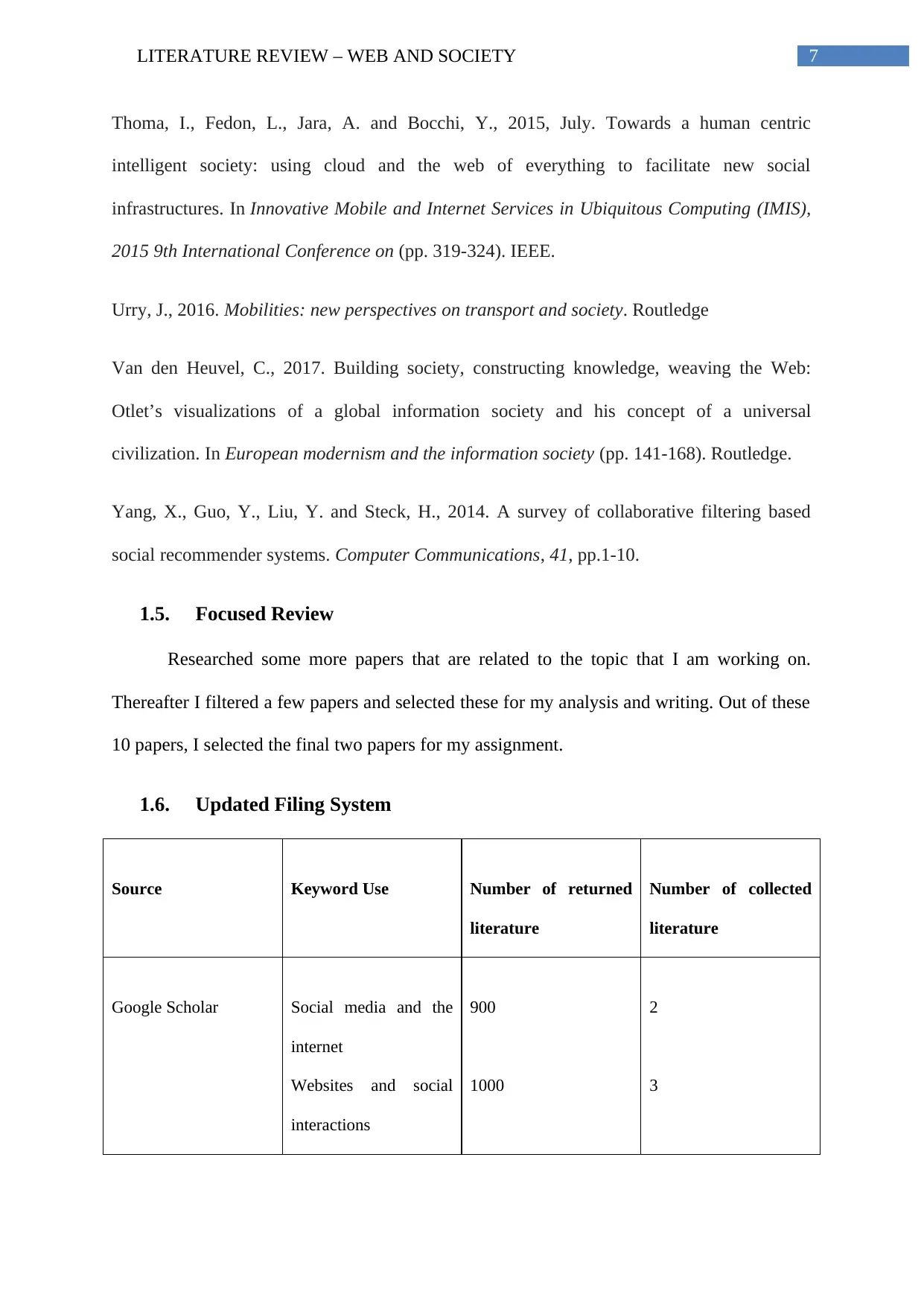
7LITERATURE REVIEW – WEB AND SOCIETY
Thoma, I., Fedon, L., Jara, A. and Bocchi, Y., 2015, July. Towards a human centric
intelligent society: using cloud and the web of everything to facilitate new social
infrastructures. In Innovative Mobile and Internet Services in Ubiquitous Computing (IMIS),
2015 9th International Conference on (pp. 319-324). IEEE.
Urry, J., 2016. Mobilities: new perspectives on transport and society. Routledge
Van den Heuvel, C., 2017. Building society, constructing knowledge, weaving the Web:
Otlet’s visualizations of a global information society and his concept of a universal
civilization. In European modernism and the information society (pp. 141-168). Routledge.
Yang, X., Guo, Y., Liu, Y. and Steck, H., 2014. A survey of collaborative filtering based
social recommender systems. Computer Communications, 41, pp.1-10.
1.5. Focused Review
Researched some more papers that are related to the topic that I am working on.
Thereafter I filtered a few papers and selected these for my analysis and writing. Out of these
10 papers, I selected the final two papers for my assignment.
1.6. Updated Filing System
Source Keyword Use Number of returned
literature
Number of collected
literature
Google Scholar Social media and the
internet
Websites and social
interactions
900
1000
2
3
Thoma, I., Fedon, L., Jara, A. and Bocchi, Y., 2015, July. Towards a human centric
intelligent society: using cloud and the web of everything to facilitate new social
infrastructures. In Innovative Mobile and Internet Services in Ubiquitous Computing (IMIS),
2015 9th International Conference on (pp. 319-324). IEEE.
Urry, J., 2016. Mobilities: new perspectives on transport and society. Routledge
Van den Heuvel, C., 2017. Building society, constructing knowledge, weaving the Web:
Otlet’s visualizations of a global information society and his concept of a universal
civilization. In European modernism and the information society (pp. 141-168). Routledge.
Yang, X., Guo, Y., Liu, Y. and Steck, H., 2014. A survey of collaborative filtering based
social recommender systems. Computer Communications, 41, pp.1-10.
1.5. Focused Review
Researched some more papers that are related to the topic that I am working on.
Thereafter I filtered a few papers and selected these for my analysis and writing. Out of these
10 papers, I selected the final two papers for my assignment.
1.6. Updated Filing System
Source Keyword Use Number of returned
literature
Number of collected
literature
Google Scholar Social media and the
internet
Websites and social
interactions
900
1000
2
3

8LITERATURE REVIEW – WEB AND SOCIETY
VU Library Interacting socially on
the web
Societies online
Online social networks
10,0000
5000
4000
2
1
1
IEEE Social engagements on
the web
600 1
1.7. Updated Bibliographic File from Focused Review
Carr, C.T. and Hayes, R.A., 2015. Social media: Defining, developing, and divining. Atlantic
Journal of Communication, 23(1), pp.46-65.
Chen, W., Paik, I. and Hung, P.C., 2015. Constructing a global social service network for
better quality of web service discovery. IEEE transactions on services computing, 8(2),
pp.284-298.
Kiang, A. and Lee, D.T., Box Inc, 2015. Central management and control of user-
contributed content in a web-based collaboration environment and management console
thereof. U.S. Patent 9,197,718.
Lu, B., Fan, W. and Zhou, M., 2016. Social presence, trust, and social commerce purchase
intention: An empirical research. Computers in Human Behavior, 56, pp.225-237
Myers, D.G., 2016, January. A Social Psychology of the Internet. In International Forum of
Teaching and Studies (Vol. 12, No. 1, p. 3). American Scholars Press, Inc.
VU Library Interacting socially on
the web
Societies online
Online social networks
10,0000
5000
4000
2
1
1
IEEE Social engagements on
the web
600 1
1.7. Updated Bibliographic File from Focused Review
Carr, C.T. and Hayes, R.A., 2015. Social media: Defining, developing, and divining. Atlantic
Journal of Communication, 23(1), pp.46-65.
Chen, W., Paik, I. and Hung, P.C., 2015. Constructing a global social service network for
better quality of web service discovery. IEEE transactions on services computing, 8(2),
pp.284-298.
Kiang, A. and Lee, D.T., Box Inc, 2015. Central management and control of user-
contributed content in a web-based collaboration environment and management console
thereof. U.S. Patent 9,197,718.
Lu, B., Fan, W. and Zhou, M., 2016. Social presence, trust, and social commerce purchase
intention: An empirical research. Computers in Human Behavior, 56, pp.225-237
Myers, D.G., 2016, January. A Social Psychology of the Internet. In International Forum of
Teaching and Studies (Vol. 12, No. 1, p. 3). American Scholars Press, Inc.
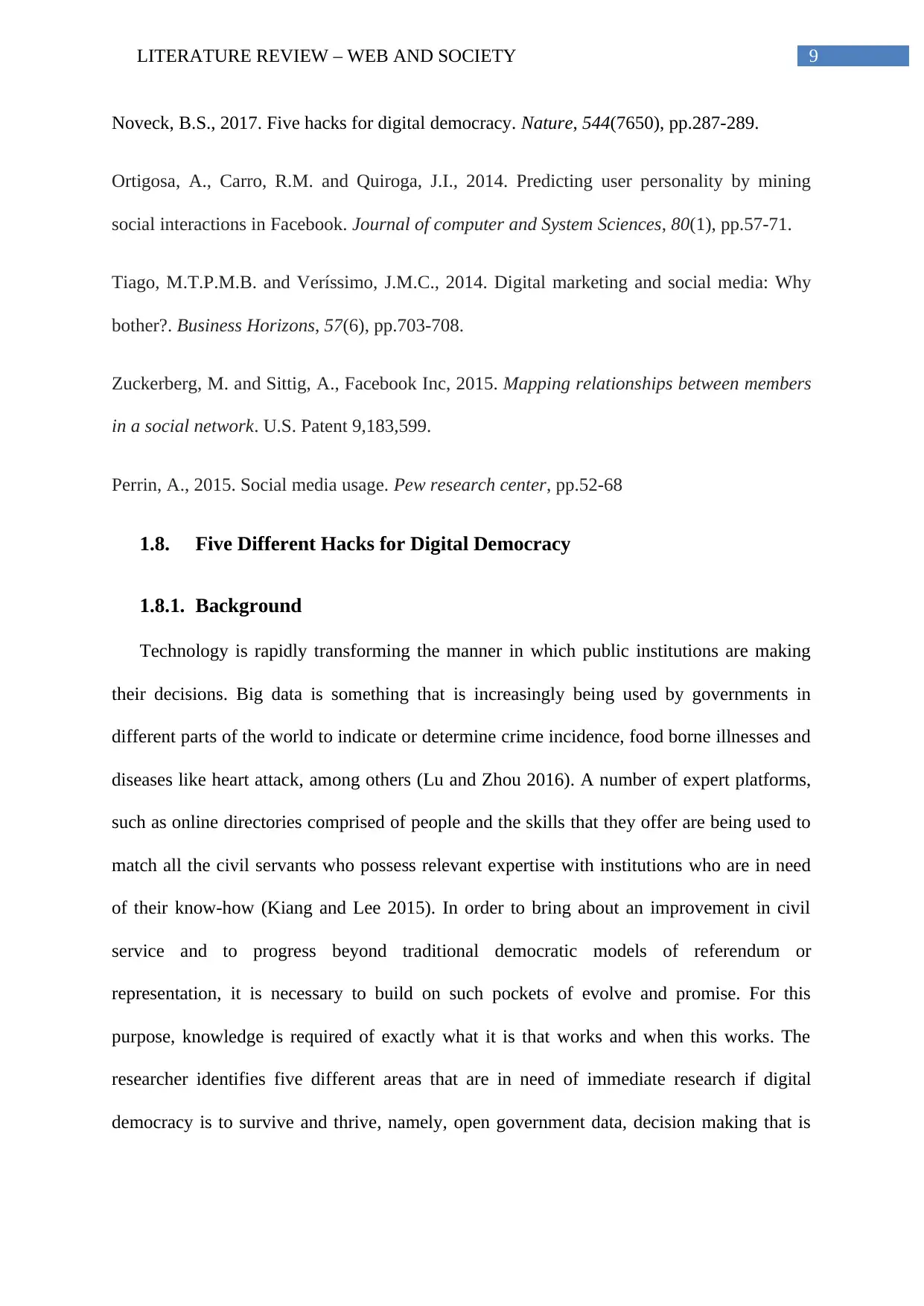
9LITERATURE REVIEW – WEB AND SOCIETY
Noveck, B.S., 2017. Five hacks for digital democracy. Nature, 544(7650), pp.287-289.
Ortigosa, A., Carro, R.M. and Quiroga, J.I., 2014. Predicting user personality by mining
social interactions in Facebook. Journal of computer and System Sciences, 80(1), pp.57-71.
Tiago, M.T.P.M.B. and Veríssimo, J.M.C., 2014. Digital marketing and social media: Why
bother?. Business Horizons, 57(6), pp.703-708.
Zuckerberg, M. and Sittig, A., Facebook Inc, 2015. Mapping relationships between members
in a social network. U.S. Patent 9,183,599.
Perrin, A., 2015. Social media usage. Pew research center, pp.52-68
1.8. Five Different Hacks for Digital Democracy
1.8.1. Background
Technology is rapidly transforming the manner in which public institutions are making
their decisions. Big data is something that is increasingly being used by governments in
different parts of the world to indicate or determine crime incidence, food borne illnesses and
diseases like heart attack, among others (Lu and Zhou 2016). A number of expert platforms,
such as online directories comprised of people and the skills that they offer are being used to
match all the civil servants who possess relevant expertise with institutions who are in need
of their know-how (Kiang and Lee 2015). In order to bring about an improvement in civil
service and to progress beyond traditional democratic models of referendum or
representation, it is necessary to build on such pockets of evolve and promise. For this
purpose, knowledge is required of exactly what it is that works and when this works. The
researcher identifies five different areas that are in need of immediate research if digital
democracy is to survive and thrive, namely, open government data, decision making that is
Noveck, B.S., 2017. Five hacks for digital democracy. Nature, 544(7650), pp.287-289.
Ortigosa, A., Carro, R.M. and Quiroga, J.I., 2014. Predicting user personality by mining
social interactions in Facebook. Journal of computer and System Sciences, 80(1), pp.57-71.
Tiago, M.T.P.M.B. and Veríssimo, J.M.C., 2014. Digital marketing and social media: Why
bother?. Business Horizons, 57(6), pp.703-708.
Zuckerberg, M. and Sittig, A., Facebook Inc, 2015. Mapping relationships between members
in a social network. U.S. Patent 9,183,599.
Perrin, A., 2015. Social media usage. Pew research center, pp.52-68
1.8. Five Different Hacks for Digital Democracy
1.8.1. Background
Technology is rapidly transforming the manner in which public institutions are making
their decisions. Big data is something that is increasingly being used by governments in
different parts of the world to indicate or determine crime incidence, food borne illnesses and
diseases like heart attack, among others (Lu and Zhou 2016). A number of expert platforms,
such as online directories comprised of people and the skills that they offer are being used to
match all the civil servants who possess relevant expertise with institutions who are in need
of their know-how (Kiang and Lee 2015). In order to bring about an improvement in civil
service and to progress beyond traditional democratic models of referendum or
representation, it is necessary to build on such pockets of evolve and promise. For this
purpose, knowledge is required of exactly what it is that works and when this works. The
researcher identifies five different areas that are in need of immediate research if digital
democracy is to survive and thrive, namely, open government data, decision making that is
Secure Best Marks with AI Grader
Need help grading? Try our AI Grader for instant feedback on your assignments.
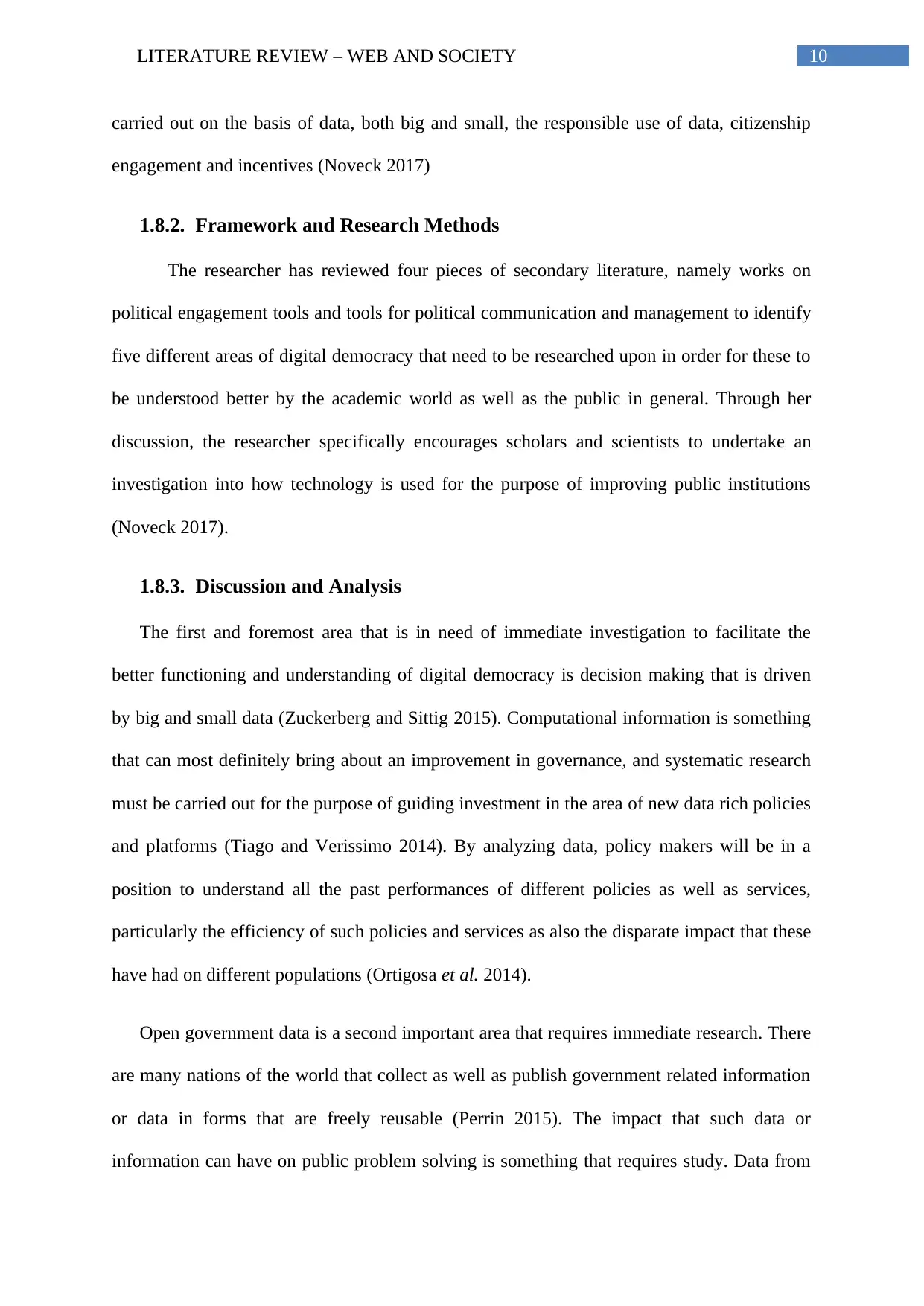
10LITERATURE REVIEW – WEB AND SOCIETY
carried out on the basis of data, both big and small, the responsible use of data, citizenship
engagement and incentives (Noveck 2017)
1.8.2. Framework and Research Methods
The researcher has reviewed four pieces of secondary literature, namely works on
political engagement tools and tools for political communication and management to identify
five different areas of digital democracy that need to be researched upon in order for these to
be understood better by the academic world as well as the public in general. Through her
discussion, the researcher specifically encourages scholars and scientists to undertake an
investigation into how technology is used for the purpose of improving public institutions
(Noveck 2017).
1.8.3. Discussion and Analysis
The first and foremost area that is in need of immediate investigation to facilitate the
better functioning and understanding of digital democracy is decision making that is driven
by big and small data (Zuckerberg and Sittig 2015). Computational information is something
that can most definitely bring about an improvement in governance, and systematic research
must be carried out for the purpose of guiding investment in the area of new data rich policies
and platforms (Tiago and Verissimo 2014). By analyzing data, policy makers will be in a
position to understand all the past performances of different policies as well as services,
particularly the efficiency of such policies and services as also the disparate impact that these
have had on different populations (Ortigosa et al. 2014).
Open government data is a second important area that requires immediate research. There
are many nations of the world that collect as well as publish government related information
or data in forms that are freely reusable (Perrin 2015). The impact that such data or
information can have on public problem solving is something that requires study. Data from
carried out on the basis of data, both big and small, the responsible use of data, citizenship
engagement and incentives (Noveck 2017)
1.8.2. Framework and Research Methods
The researcher has reviewed four pieces of secondary literature, namely works on
political engagement tools and tools for political communication and management to identify
five different areas of digital democracy that need to be researched upon in order for these to
be understood better by the academic world as well as the public in general. Through her
discussion, the researcher specifically encourages scholars and scientists to undertake an
investigation into how technology is used for the purpose of improving public institutions
(Noveck 2017).
1.8.3. Discussion and Analysis
The first and foremost area that is in need of immediate investigation to facilitate the
better functioning and understanding of digital democracy is decision making that is driven
by big and small data (Zuckerberg and Sittig 2015). Computational information is something
that can most definitely bring about an improvement in governance, and systematic research
must be carried out for the purpose of guiding investment in the area of new data rich policies
and platforms (Tiago and Verissimo 2014). By analyzing data, policy makers will be in a
position to understand all the past performances of different policies as well as services,
particularly the efficiency of such policies and services as also the disparate impact that these
have had on different populations (Ortigosa et al. 2014).
Open government data is a second important area that requires immediate research. There
are many nations of the world that collect as well as publish government related information
or data in forms that are freely reusable (Perrin 2015). The impact that such data or
information can have on public problem solving is something that requires study. Data from
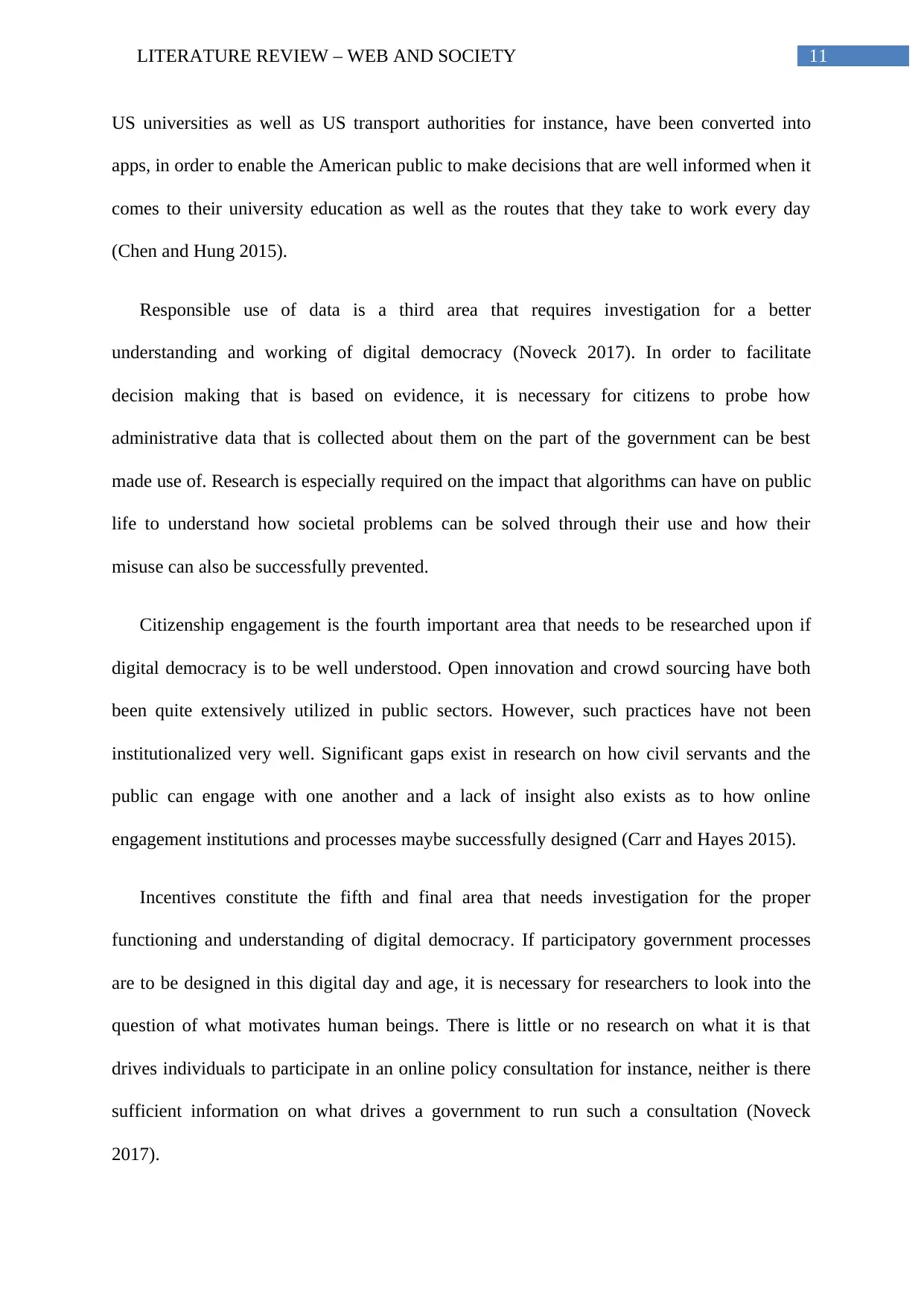
11LITERATURE REVIEW – WEB AND SOCIETY
US universities as well as US transport authorities for instance, have been converted into
apps, in order to enable the American public to make decisions that are well informed when it
comes to their university education as well as the routes that they take to work every day
(Chen and Hung 2015).
Responsible use of data is a third area that requires investigation for a better
understanding and working of digital democracy (Noveck 2017). In order to facilitate
decision making that is based on evidence, it is necessary for citizens to probe how
administrative data that is collected about them on the part of the government can be best
made use of. Research is especially required on the impact that algorithms can have on public
life to understand how societal problems can be solved through their use and how their
misuse can also be successfully prevented.
Citizenship engagement is the fourth important area that needs to be researched upon if
digital democracy is to be well understood. Open innovation and crowd sourcing have both
been quite extensively utilized in public sectors. However, such practices have not been
institutionalized very well. Significant gaps exist in research on how civil servants and the
public can engage with one another and a lack of insight also exists as to how online
engagement institutions and processes maybe successfully designed (Carr and Hayes 2015).
Incentives constitute the fifth and final area that needs investigation for the proper
functioning and understanding of digital democracy. If participatory government processes
are to be designed in this digital day and age, it is necessary for researchers to look into the
question of what motivates human beings. There is little or no research on what it is that
drives individuals to participate in an online policy consultation for instance, neither is there
sufficient information on what drives a government to run such a consultation (Noveck
2017).
US universities as well as US transport authorities for instance, have been converted into
apps, in order to enable the American public to make decisions that are well informed when it
comes to their university education as well as the routes that they take to work every day
(Chen and Hung 2015).
Responsible use of data is a third area that requires investigation for a better
understanding and working of digital democracy (Noveck 2017). In order to facilitate
decision making that is based on evidence, it is necessary for citizens to probe how
administrative data that is collected about them on the part of the government can be best
made use of. Research is especially required on the impact that algorithms can have on public
life to understand how societal problems can be solved through their use and how their
misuse can also be successfully prevented.
Citizenship engagement is the fourth important area that needs to be researched upon if
digital democracy is to be well understood. Open innovation and crowd sourcing have both
been quite extensively utilized in public sectors. However, such practices have not been
institutionalized very well. Significant gaps exist in research on how civil servants and the
public can engage with one another and a lack of insight also exists as to how online
engagement institutions and processes maybe successfully designed (Carr and Hayes 2015).
Incentives constitute the fifth and final area that needs investigation for the proper
functioning and understanding of digital democracy. If participatory government processes
are to be designed in this digital day and age, it is necessary for researchers to look into the
question of what motivates human beings. There is little or no research on what it is that
drives individuals to participate in an online policy consultation for instance, neither is there
sufficient information on what drives a government to run such a consultation (Noveck
2017).
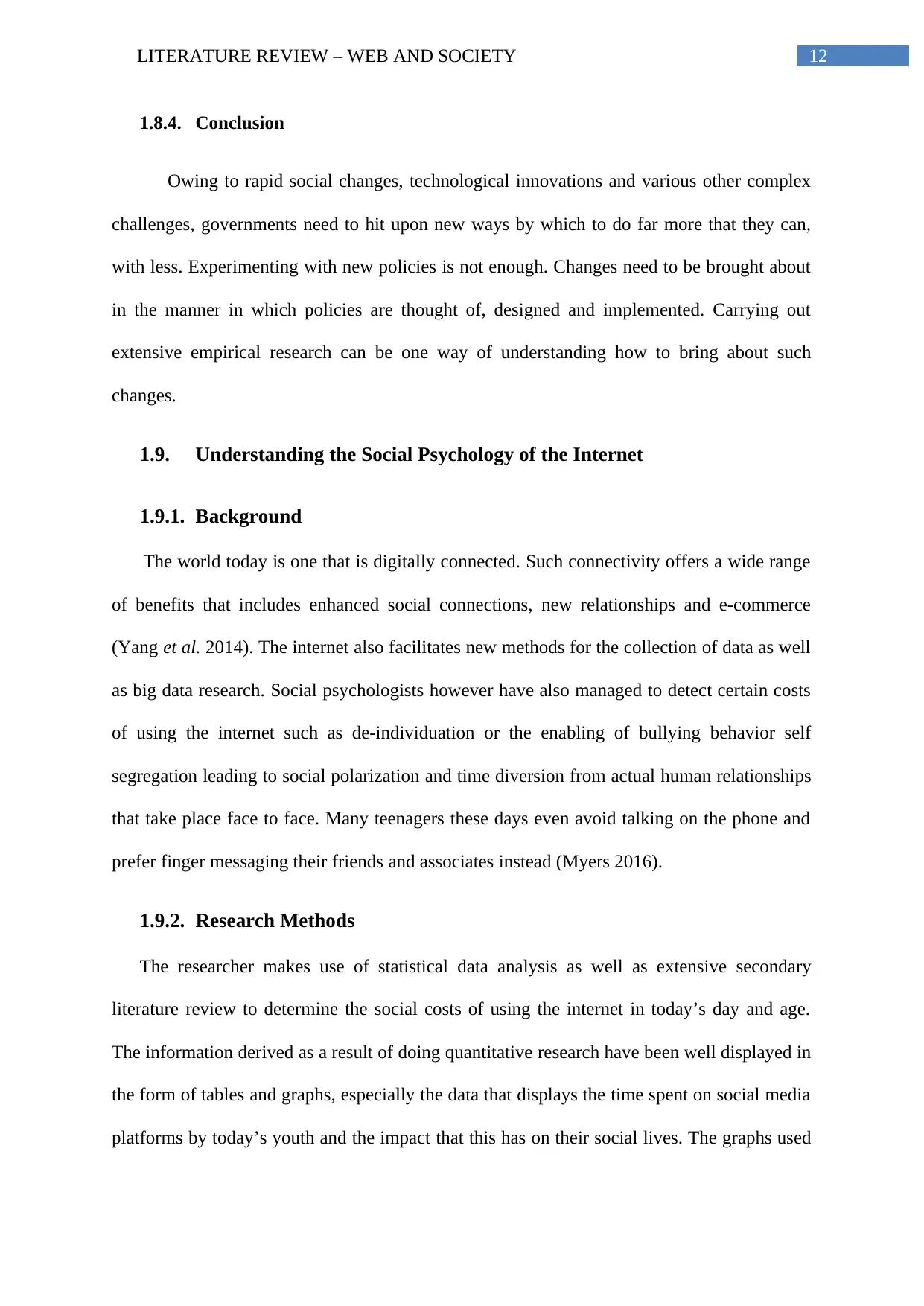
12LITERATURE REVIEW – WEB AND SOCIETY
1.8.4. Conclusion
Owing to rapid social changes, technological innovations and various other complex
challenges, governments need to hit upon new ways by which to do far more that they can,
with less. Experimenting with new policies is not enough. Changes need to be brought about
in the manner in which policies are thought of, designed and implemented. Carrying out
extensive empirical research can be one way of understanding how to bring about such
changes.
1.9. Understanding the Social Psychology of the Internet
1.9.1. Background
The world today is one that is digitally connected. Such connectivity offers a wide range
of benefits that includes enhanced social connections, new relationships and e-commerce
(Yang et al. 2014). The internet also facilitates new methods for the collection of data as well
as big data research. Social psychologists however have also managed to detect certain costs
of using the internet such as de-individuation or the enabling of bullying behavior self
segregation leading to social polarization and time diversion from actual human relationships
that take place face to face. Many teenagers these days even avoid talking on the phone and
prefer finger messaging their friends and associates instead (Myers 2016).
1.9.2. Research Methods
The researcher makes use of statistical data analysis as well as extensive secondary
literature review to determine the social costs of using the internet in today’s day and age.
The information derived as a result of doing quantitative research have been well displayed in
the form of tables and graphs, especially the data that displays the time spent on social media
platforms by today’s youth and the impact that this has on their social lives. The graphs used
1.8.4. Conclusion
Owing to rapid social changes, technological innovations and various other complex
challenges, governments need to hit upon new ways by which to do far more that they can,
with less. Experimenting with new policies is not enough. Changes need to be brought about
in the manner in which policies are thought of, designed and implemented. Carrying out
extensive empirical research can be one way of understanding how to bring about such
changes.
1.9. Understanding the Social Psychology of the Internet
1.9.1. Background
The world today is one that is digitally connected. Such connectivity offers a wide range
of benefits that includes enhanced social connections, new relationships and e-commerce
(Yang et al. 2014). The internet also facilitates new methods for the collection of data as well
as big data research. Social psychologists however have also managed to detect certain costs
of using the internet such as de-individuation or the enabling of bullying behavior self
segregation leading to social polarization and time diversion from actual human relationships
that take place face to face. Many teenagers these days even avoid talking on the phone and
prefer finger messaging their friends and associates instead (Myers 2016).
1.9.2. Research Methods
The researcher makes use of statistical data analysis as well as extensive secondary
literature review to determine the social costs of using the internet in today’s day and age.
The information derived as a result of doing quantitative research have been well displayed in
the form of tables and graphs, especially the data that displays the time spent on social media
platforms by today’s youth and the impact that this has on their social lives. The graphs used
Paraphrase This Document
Need a fresh take? Get an instant paraphrase of this document with our AI Paraphraser

13LITERATURE REVIEW – WEB AND SOCIETY
in the research are those that are quite easy to comprehend and have been quite well
illustrated too for the benefit of the readers.
1.9.3. Discussion
The researcher argues that the internet in general and social media platforms on the
internet like Facebook and Twitter in particular offer people opportunities for social
interaction. They can engage with one another and connect with each other even when they
are not in each other’s physical presence (Urry 2016). The internet in particular is widely
used for carrying out research and millions of people logging into the search engines online
every day to conduct investigations on topics and subjects that they would like to know more
about (Sharma and Kaur 2017). Yet the researcher through his study on the internet is able to
locate a number of issues as well, the first and foremost among these being de-individuation.
People become easy victims of harassment and bullying when they interact online as it is
difficult to hold the oppressor accountable due to his virtual presence or existence (Rao
2016). Online activities also lead to what the researcher terms as slacktivism. People are
content to take part in one click campaigns in order to raise money or spread awareness about
social issues and causes rather than helping out in a far more proactive way. Finally, internet
life definitely leads to self segregation. Although it gives people the opportunity to engage
and interact with one another as and when they please, they are not actually sitting in front of
people and talking or communicating in a healthy way. They are thus being self polarized,
becoming completely isolated from actual mainstream life and are content with a virtual and
to some extent, an unreal existence (Van den Heuvel 2017). The author raises the question
that in addition to isolating people from one another, social media platforms can even perhaps
be promoting self love or narcissism especially with the trend of taking selfies and posting
photos of one’s self on Twitter and Facebook being one that is so widely popular and
acceptable (Myers 2016).
in the research are those that are quite easy to comprehend and have been quite well
illustrated too for the benefit of the readers.
1.9.3. Discussion
The researcher argues that the internet in general and social media platforms on the
internet like Facebook and Twitter in particular offer people opportunities for social
interaction. They can engage with one another and connect with each other even when they
are not in each other’s physical presence (Urry 2016). The internet in particular is widely
used for carrying out research and millions of people logging into the search engines online
every day to conduct investigations on topics and subjects that they would like to know more
about (Sharma and Kaur 2017). Yet the researcher through his study on the internet is able to
locate a number of issues as well, the first and foremost among these being de-individuation.
People become easy victims of harassment and bullying when they interact online as it is
difficult to hold the oppressor accountable due to his virtual presence or existence (Rao
2016). Online activities also lead to what the researcher terms as slacktivism. People are
content to take part in one click campaigns in order to raise money or spread awareness about
social issues and causes rather than helping out in a far more proactive way. Finally, internet
life definitely leads to self segregation. Although it gives people the opportunity to engage
and interact with one another as and when they please, they are not actually sitting in front of
people and talking or communicating in a healthy way. They are thus being self polarized,
becoming completely isolated from actual mainstream life and are content with a virtual and
to some extent, an unreal existence (Van den Heuvel 2017). The author raises the question
that in addition to isolating people from one another, social media platforms can even perhaps
be promoting self love or narcissism especially with the trend of taking selfies and posting
photos of one’s self on Twitter and Facebook being one that is so widely popular and
acceptable (Myers 2016).
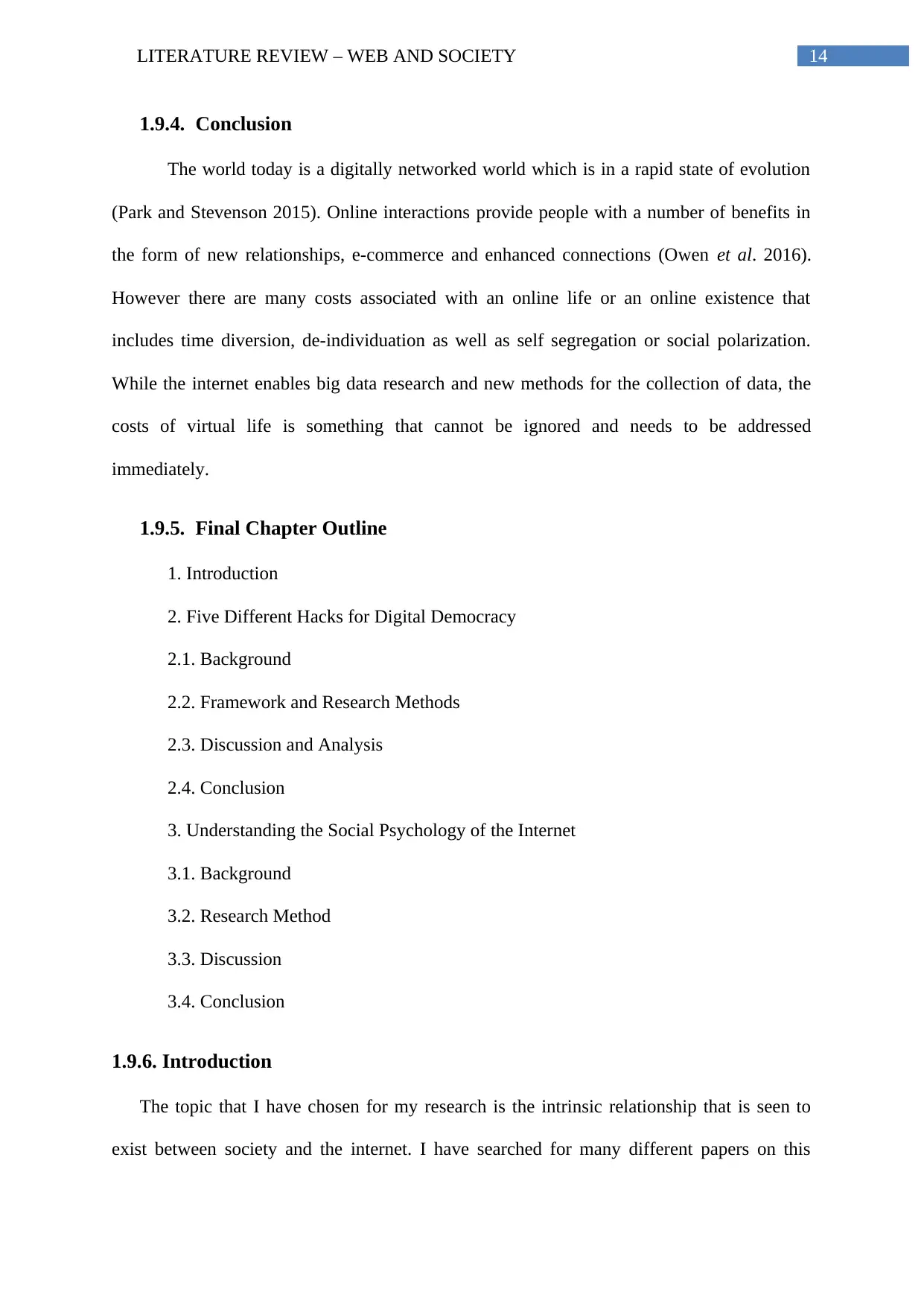
14LITERATURE REVIEW – WEB AND SOCIETY
1.9.4. Conclusion
The world today is a digitally networked world which is in a rapid state of evolution
(Park and Stevenson 2015). Online interactions provide people with a number of benefits in
the form of new relationships, e-commerce and enhanced connections (Owen et al. 2016).
However there are many costs associated with an online life or an online existence that
includes time diversion, de-individuation as well as self segregation or social polarization.
While the internet enables big data research and new methods for the collection of data, the
costs of virtual life is something that cannot be ignored and needs to be addressed
immediately.
1.9.5. Final Chapter Outline
1. Introduction
2. Five Different Hacks for Digital Democracy
2.1. Background
2.2. Framework and Research Methods
2.3. Discussion and Analysis
2.4. Conclusion
3. Understanding the Social Psychology of the Internet
3.1. Background
3.2. Research Method
3.3. Discussion
3.4. Conclusion
1.9.6. Introduction
The topic that I have chosen for my research is the intrinsic relationship that is seen to
exist between society and the internet. I have searched for many different papers on this
1.9.4. Conclusion
The world today is a digitally networked world which is in a rapid state of evolution
(Park and Stevenson 2015). Online interactions provide people with a number of benefits in
the form of new relationships, e-commerce and enhanced connections (Owen et al. 2016).
However there are many costs associated with an online life or an online existence that
includes time diversion, de-individuation as well as self segregation or social polarization.
While the internet enables big data research and new methods for the collection of data, the
costs of virtual life is something that cannot be ignored and needs to be addressed
immediately.
1.9.5. Final Chapter Outline
1. Introduction
2. Five Different Hacks for Digital Democracy
2.1. Background
2.2. Framework and Research Methods
2.3. Discussion and Analysis
2.4. Conclusion
3. Understanding the Social Psychology of the Internet
3.1. Background
3.2. Research Method
3.3. Discussion
3.4. Conclusion
1.9.6. Introduction
The topic that I have chosen for my research is the intrinsic relationship that is seen to
exist between society and the internet. I have searched for many different papers on this
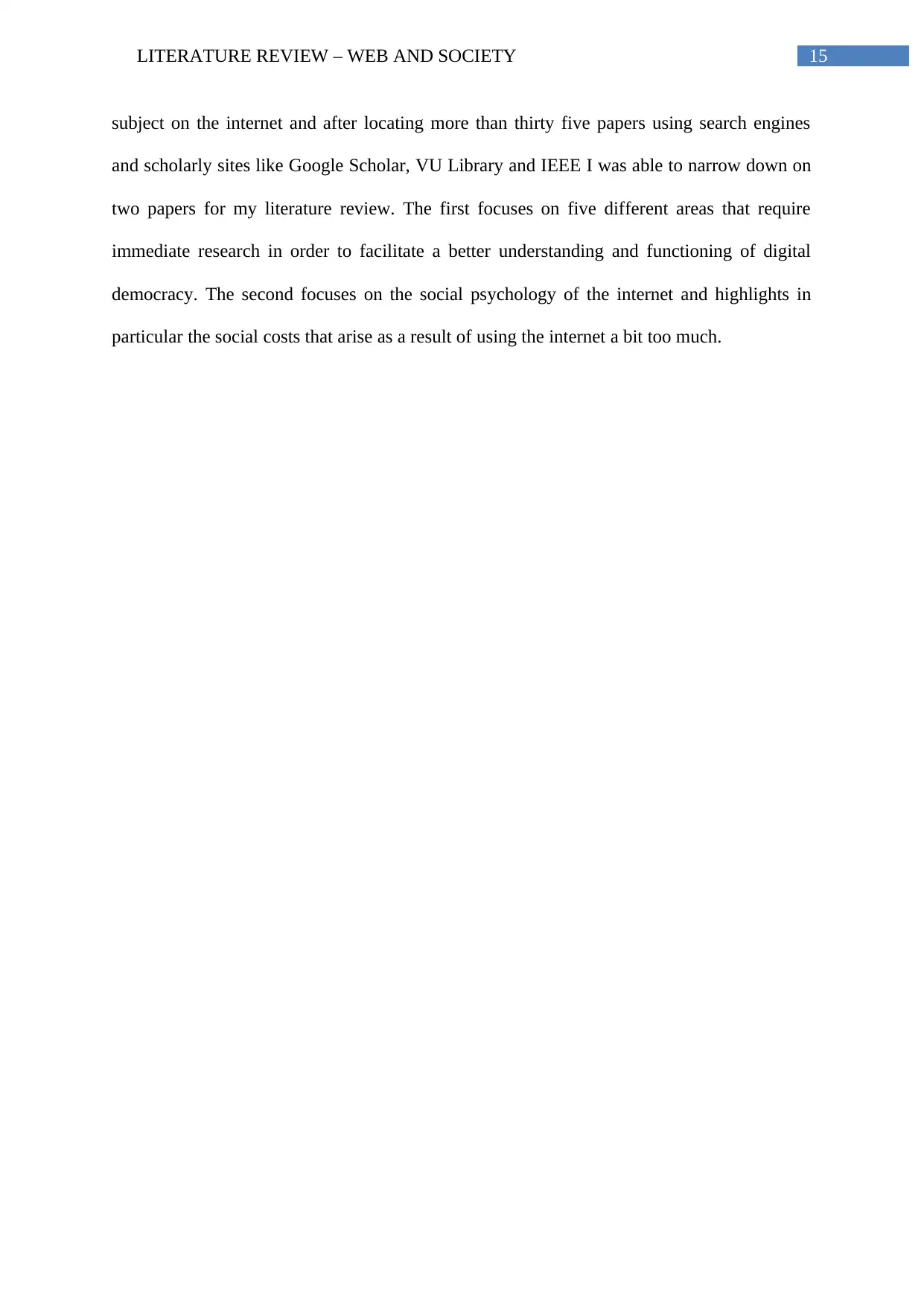
15LITERATURE REVIEW – WEB AND SOCIETY
subject on the internet and after locating more than thirty five papers using search engines
and scholarly sites like Google Scholar, VU Library and IEEE I was able to narrow down on
two papers for my literature review. The first focuses on five different areas that require
immediate research in order to facilitate a better understanding and functioning of digital
democracy. The second focuses on the social psychology of the internet and highlights in
particular the social costs that arise as a result of using the internet a bit too much.
subject on the internet and after locating more than thirty five papers using search engines
and scholarly sites like Google Scholar, VU Library and IEEE I was able to narrow down on
two papers for my literature review. The first focuses on five different areas that require
immediate research in order to facilitate a better understanding and functioning of digital
democracy. The second focuses on the social psychology of the internet and highlights in
particular the social costs that arise as a result of using the internet a bit too much.
Secure Best Marks with AI Grader
Need help grading? Try our AI Grader for instant feedback on your assignments.
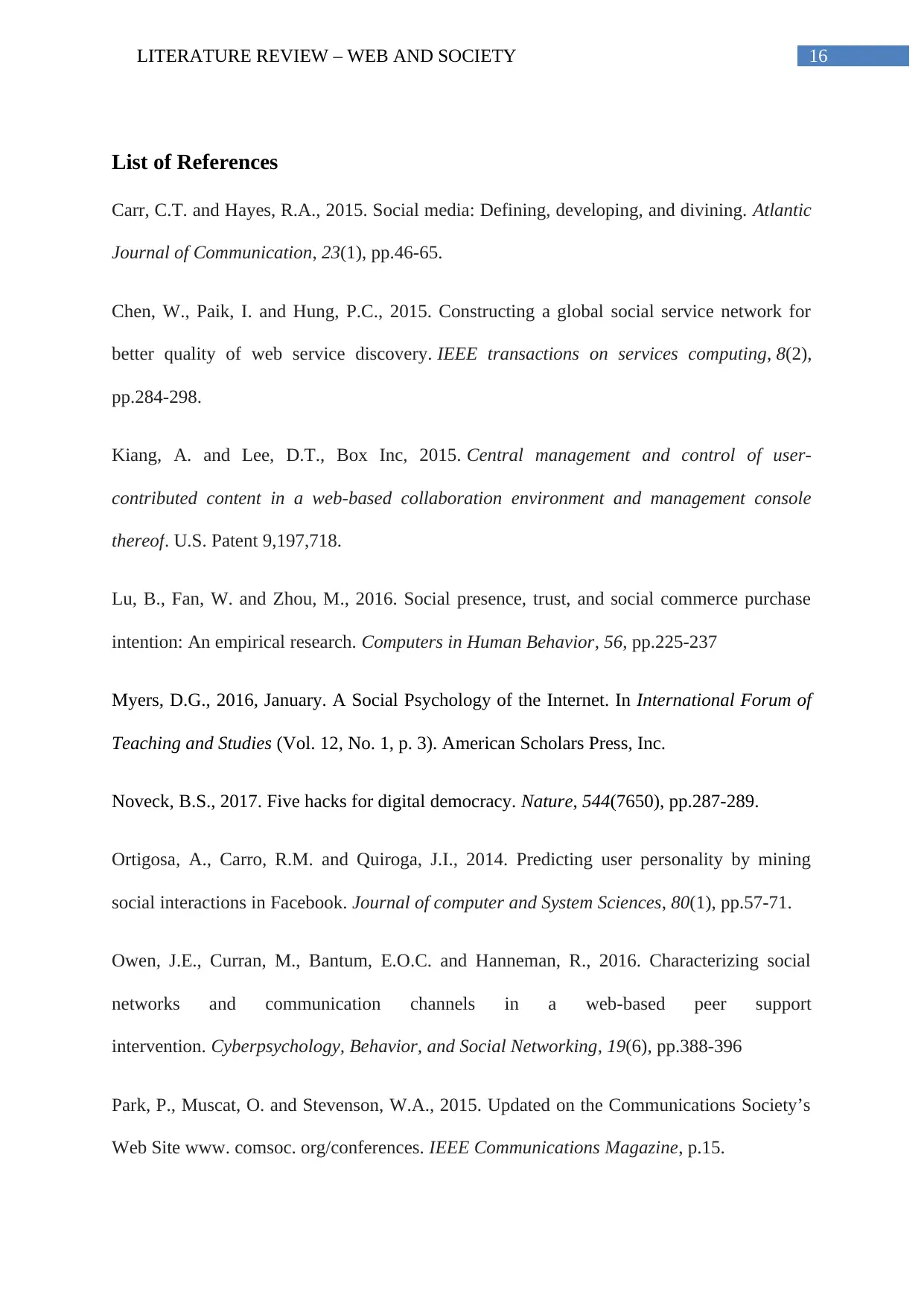
16LITERATURE REVIEW – WEB AND SOCIETY
List of References
Carr, C.T. and Hayes, R.A., 2015. Social media: Defining, developing, and divining. Atlantic
Journal of Communication, 23(1), pp.46-65.
Chen, W., Paik, I. and Hung, P.C., 2015. Constructing a global social service network for
better quality of web service discovery. IEEE transactions on services computing, 8(2),
pp.284-298.
Kiang, A. and Lee, D.T., Box Inc, 2015. Central management and control of user-
contributed content in a web-based collaboration environment and management console
thereof. U.S. Patent 9,197,718.
Lu, B., Fan, W. and Zhou, M., 2016. Social presence, trust, and social commerce purchase
intention: An empirical research. Computers in Human Behavior, 56, pp.225-237
Myers, D.G., 2016, January. A Social Psychology of the Internet. In International Forum of
Teaching and Studies (Vol. 12, No. 1, p. 3). American Scholars Press, Inc.
Noveck, B.S., 2017. Five hacks for digital democracy. Nature, 544(7650), pp.287-289.
Ortigosa, A., Carro, R.M. and Quiroga, J.I., 2014. Predicting user personality by mining
social interactions in Facebook. Journal of computer and System Sciences, 80(1), pp.57-71.
Owen, J.E., Curran, M., Bantum, E.O.C. and Hanneman, R., 2016. Characterizing social
networks and communication channels in a web-based peer support
intervention. Cyberpsychology, Behavior, and Social Networking, 19(6), pp.388-396
Park, P., Muscat, O. and Stevenson, W.A., 2015. Updated on the Communications Society’s
Web Site www. comsoc. org/conferences. IEEE Communications Magazine, p.15.
List of References
Carr, C.T. and Hayes, R.A., 2015. Social media: Defining, developing, and divining. Atlantic
Journal of Communication, 23(1), pp.46-65.
Chen, W., Paik, I. and Hung, P.C., 2015. Constructing a global social service network for
better quality of web service discovery. IEEE transactions on services computing, 8(2),
pp.284-298.
Kiang, A. and Lee, D.T., Box Inc, 2015. Central management and control of user-
contributed content in a web-based collaboration environment and management console
thereof. U.S. Patent 9,197,718.
Lu, B., Fan, W. and Zhou, M., 2016. Social presence, trust, and social commerce purchase
intention: An empirical research. Computers in Human Behavior, 56, pp.225-237
Myers, D.G., 2016, January. A Social Psychology of the Internet. In International Forum of
Teaching and Studies (Vol. 12, No. 1, p. 3). American Scholars Press, Inc.
Noveck, B.S., 2017. Five hacks for digital democracy. Nature, 544(7650), pp.287-289.
Ortigosa, A., Carro, R.M. and Quiroga, J.I., 2014. Predicting user personality by mining
social interactions in Facebook. Journal of computer and System Sciences, 80(1), pp.57-71.
Owen, J.E., Curran, M., Bantum, E.O.C. and Hanneman, R., 2016. Characterizing social
networks and communication channels in a web-based peer support
intervention. Cyberpsychology, Behavior, and Social Networking, 19(6), pp.388-396
Park, P., Muscat, O. and Stevenson, W.A., 2015. Updated on the Communications Society’s
Web Site www. comsoc. org/conferences. IEEE Communications Magazine, p.15.
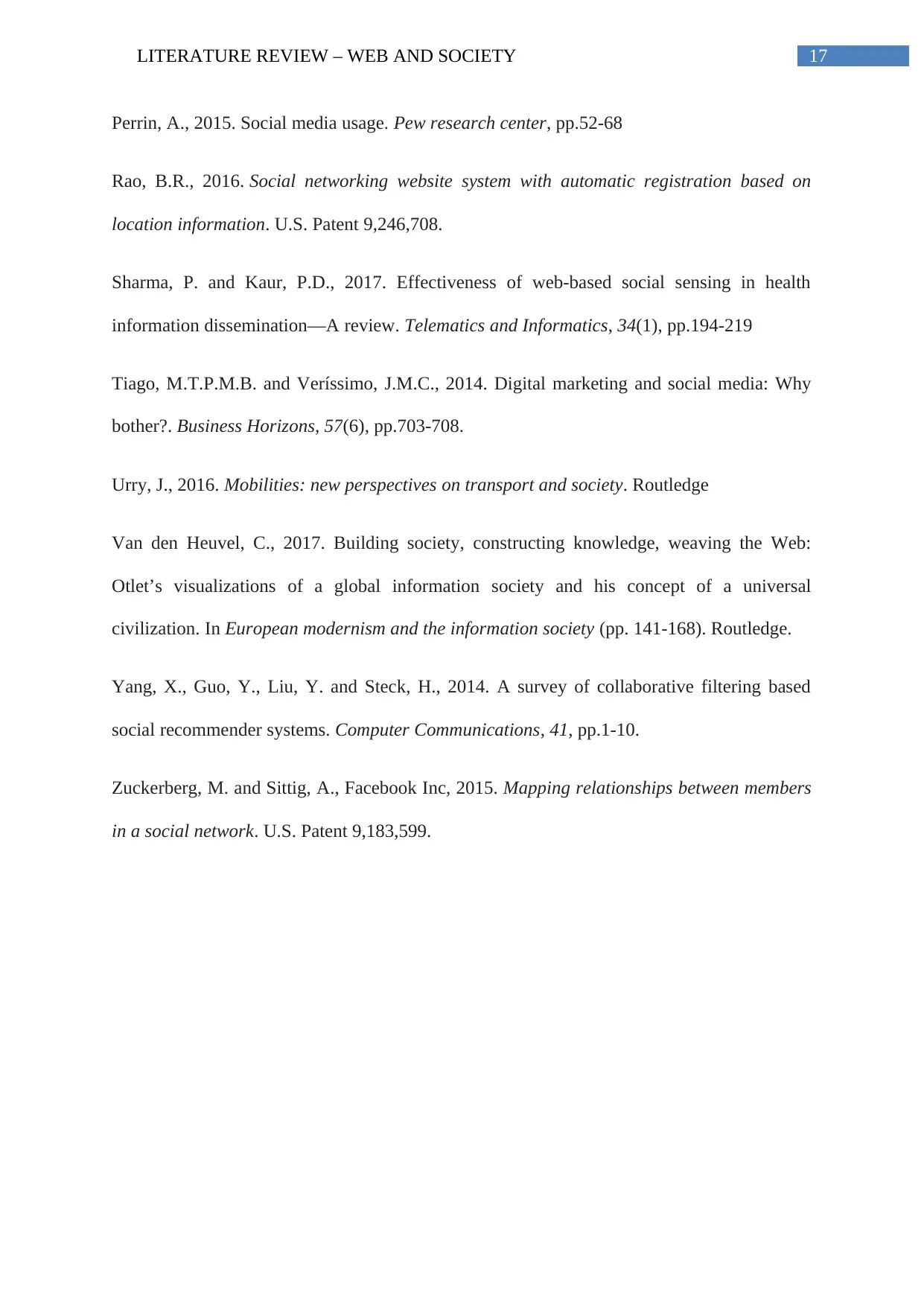
17LITERATURE REVIEW – WEB AND SOCIETY
Perrin, A., 2015. Social media usage. Pew research center, pp.52-68
Rao, B.R., 2016. Social networking website system with automatic registration based on
location information. U.S. Patent 9,246,708.
Sharma, P. and Kaur, P.D., 2017. Effectiveness of web-based social sensing in health
information dissemination—A review. Telematics and Informatics, 34(1), pp.194-219
Tiago, M.T.P.M.B. and Veríssimo, J.M.C., 2014. Digital marketing and social media: Why
bother?. Business Horizons, 57(6), pp.703-708.
Urry, J., 2016. Mobilities: new perspectives on transport and society. Routledge
Van den Heuvel, C., 2017. Building society, constructing knowledge, weaving the Web:
Otlet’s visualizations of a global information society and his concept of a universal
civilization. In European modernism and the information society (pp. 141-168). Routledge.
Yang, X., Guo, Y., Liu, Y. and Steck, H., 2014. A survey of collaborative filtering based
social recommender systems. Computer Communications, 41, pp.1-10.
Zuckerberg, M. and Sittig, A., Facebook Inc, 2015. Mapping relationships between members
in a social network. U.S. Patent 9,183,599.
Perrin, A., 2015. Social media usage. Pew research center, pp.52-68
Rao, B.R., 2016. Social networking website system with automatic registration based on
location information. U.S. Patent 9,246,708.
Sharma, P. and Kaur, P.D., 2017. Effectiveness of web-based social sensing in health
information dissemination—A review. Telematics and Informatics, 34(1), pp.194-219
Tiago, M.T.P.M.B. and Veríssimo, J.M.C., 2014. Digital marketing and social media: Why
bother?. Business Horizons, 57(6), pp.703-708.
Urry, J., 2016. Mobilities: new perspectives on transport and society. Routledge
Van den Heuvel, C., 2017. Building society, constructing knowledge, weaving the Web:
Otlet’s visualizations of a global information society and his concept of a universal
civilization. In European modernism and the information society (pp. 141-168). Routledge.
Yang, X., Guo, Y., Liu, Y. and Steck, H., 2014. A survey of collaborative filtering based
social recommender systems. Computer Communications, 41, pp.1-10.
Zuckerberg, M. and Sittig, A., Facebook Inc, 2015. Mapping relationships between members
in a social network. U.S. Patent 9,183,599.
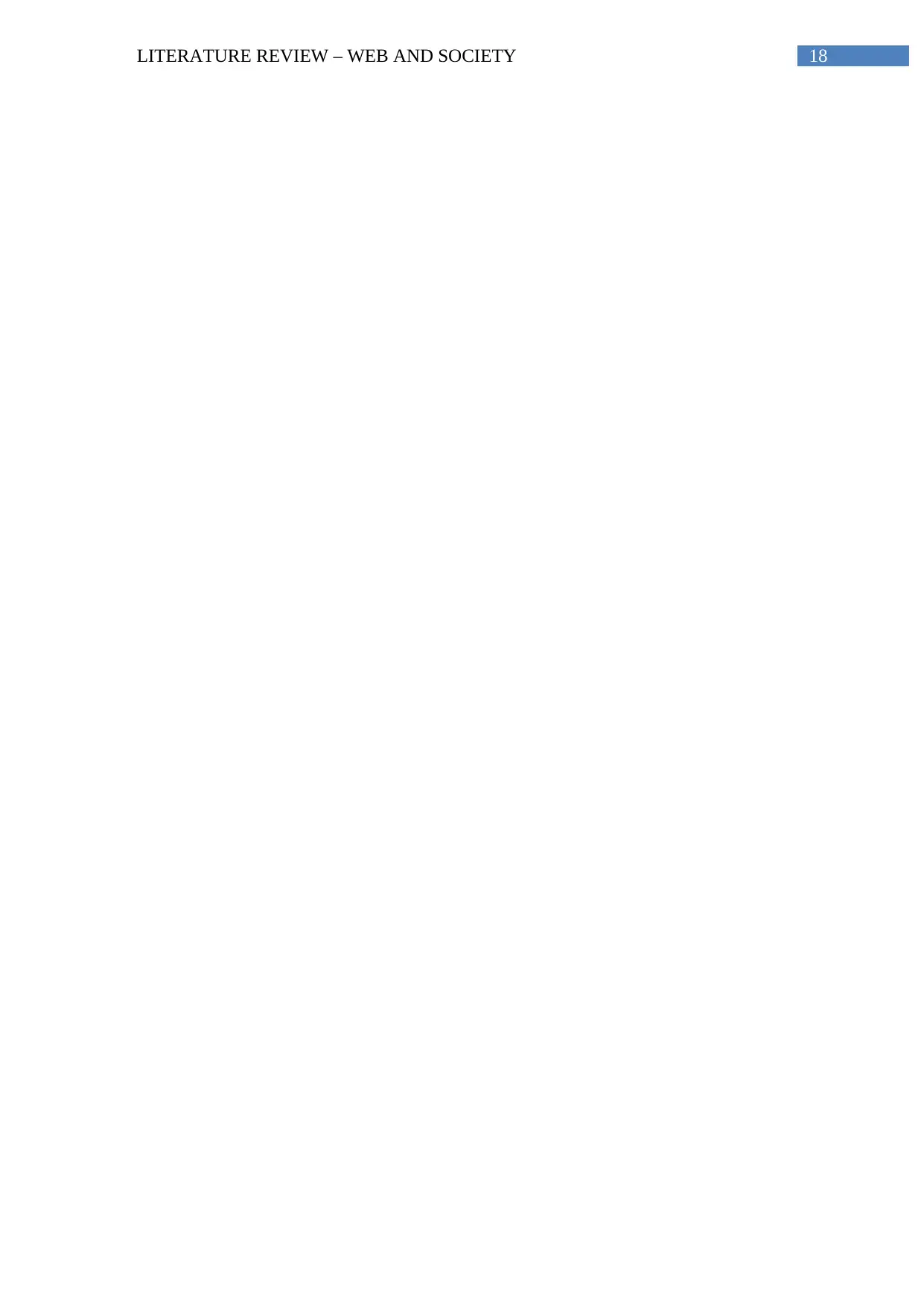
18LITERATURE REVIEW – WEB AND SOCIETY
1 out of 19
Related Documents
Your All-in-One AI-Powered Toolkit for Academic Success.
+13062052269
info@desklib.com
Available 24*7 on WhatsApp / Email
![[object Object]](/_next/static/media/star-bottom.7253800d.svg)
Unlock your academic potential
© 2024 | Zucol Services PVT LTD | All rights reserved.





